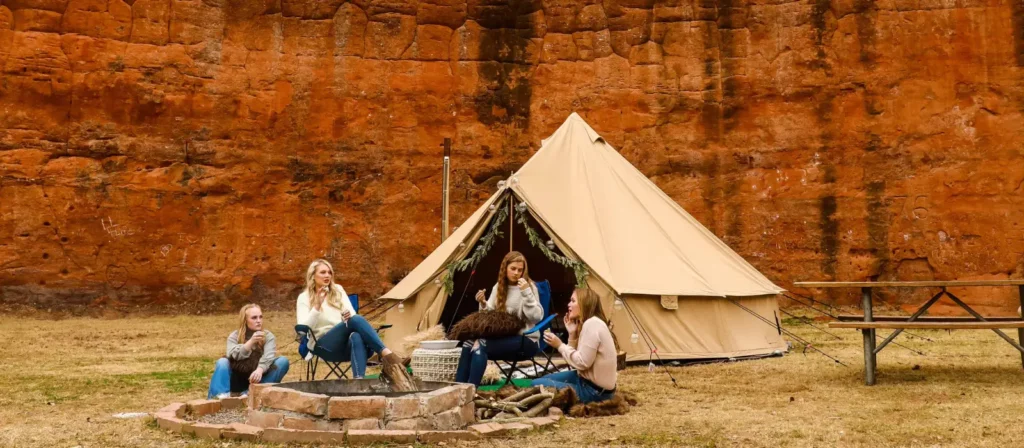Uncategorized
“How to Choose the Right Camping Tent for Different Weather Conditions
When it comes to camping, the tent is your home away from home. It’s your refuge from the elements, providing shelter and safety during your outdoor adventure. However, the right tent for your trip depends largely on the weather conditions you’ll encounter. Whether you’re camping in the warmth of summer, braving a rainy spring, or tackling the snow-covered landscapes of winter, choosing the correct tent is crucial for comfort and safety. In this guide, we’ll walk you through how to select the best camping tent for different weather conditions.
1. Summer Camping Tents: Light, Breezy, and Ventilated
During the summer, the primary concern is staying cool, dry, and comfortable. You’ll want a tent that offers good ventilation, so you don’t overheat or get too humid inside.
Key Features to Look for in a Summer Tent:
- Breathability: Look for a tent with mesh panels or large windows to allow air to circulate freely. Mesh is particularly important in warmer weather to prevent condensation and provide ventilation.
- Lightweight and Compact: In summer, you’ll likely be backpacking or hiking to your campsite, so you’ll need a tent that’s lightweight and easy to carry. Two-season tents or three-season tents (designed for moderate weather) are ideal for summer trips.
- Easy Setup: Since summer camping is often more relaxed, you’ll want a tent that is quick and simple to pitch. Look for models with color-coded poles or instant setup systems to reduce the hassle.
- UV Protection: A tent with a UV-resistant coating will protect you from the sun’s harmful rays. This is especially important if you’re camping in an exposed area with little shade.
Recommended Summer Tent Options:
- REI Co-op Half Dome 2 Plus: This is a three-season tent that offers excellent ventilation, a spacious interior, and great weather resistance for summer nights.
- Big Agnes Copper Spur HV UL2: A lightweight, 2-person tent designed with excellent airflow and enough space for comfort, ideal for summer camping.
2. Rainy Weather Camping Tents: Waterproof and Sturdy
Rain is an inevitable part of camping, especially in spring and fall, and being unprepared can turn a pleasant trip into a soggy disaster. When choosing a tent for rainy conditions, focus on waterproofing, durability, and keeping your interior dry.
Key Features to Look for in a Rainy Weather Tent:
- Waterproofing: Ensure the tent has a waterproof rainfly with a high hydrostatic head rating (typically 1500 mm or higher). The rainfly should cover the entire tent, including the floor, to prevent water from seeping in. Look for seams that are sealed or taped, as this will help keep water from leaking through.
- Double-Wall Construction: A double-wall tent provides an additional layer of protection against rain. The inner tent keeps you dry and breathable, while the outer rainfly deflects water.
- Good Drainage: Make sure the tent has a high bathtub floor design that extends a few inches up the sides. This keeps water from running inside when it rains heavily.
- Ventilation: Even in rainy conditions, you’ll need good ventilation to avoid condensation inside the tent. Look for tents with adjustable vents that can be opened to release moisture.
Recommended Rainy Weather Tent Options:
- MSR Hubba Hubba NX 2: This two-person tent is designed to handle heavy rain with its full-coverage rainfly and excellent waterproofing features.
- The North Face Stormbreak 2: A great budget-friendly option, this three-season tent offers reliable waterproofing and solid durability for rainy weather.
3. Windy Weather Camping Tents: Stability and Durability
When camping in areas prone to high winds, such as coastal regions or mountain ranges, it’s essential to choose a tent that can withstand gusty conditions. Wind can cause tents to collapse or collapse, but a sturdy model will ensure a safe, comfortable night.
Key Features to Look for in a Wind-Resistant Tent:
- Aerodynamic Design: Look for a tent with a low-profile or dome shape that can shed wind efficiently. These designs help minimize the force of wind against the tent’s walls.
- Strong Poles: Opt for tents with aluminum poles or DAC poles for their strength and flexibility. These materials are less likely to bend or snap compared to fiberglass poles.
- Multiple Stake Points: Ensure that the tent has multiple guy-out points to attach extra guy lines and stake it securely. Some tents come with a storm guy line kit designed to enhance stability during high winds.
- Double-Wall Construction: A double-wall design will allow the tent to stand up better in windy conditions. The inner tent offers structural support, while the rainfly offers additional protection.
Recommended Wind-Resistant Tent Options:
- Big Agnes Tiger Wall UL2: This lightweight two-person tent offers high wind-resistance thanks to its aerodynamic design and durable materials.
- Mountain Hardwear Trango 2: A robust four-season tent with excellent stability in harsh winds, designed for alpine environments.
4. Winter Camping Tents: Cold, Snow, and Wind Protection
Winter camping presents the most extreme weather conditions. The tent you choose must be able to handle cold temperatures, snow accumulation, and high winds while keeping you insulated and dry.
Key Features to Look for in a Winter Tent:
- Four-Season Tent: These tents are specifically built to handle winter conditions. Unlike three-season tents, four-season models are designed to withstand heavier snow, stronger winds, and more extreme temperatures.
- Heavy-Duty Frame: Look for tents with strong aluminum poles that can withstand heavy snow loads and high winds. Some models also feature cross-pole structures for added strength and stability.
- Snow-Specific Design: Four-season tents often have a sloped roof that sheds snow easily, reducing the chance of snow accumulation on top.
- Windproof and Waterproof: A tent with a full-coverage rainfly is essential for keeping out snow and wind. Make sure it’s highly waterproof and windproof.
- Insulated Flooring: Consider a tent with an insulated or reflective floor to help retain heat during colder nights.
Recommended Winter Tent Options:
- Hilleberg Jannu: A top-of-the-line four-season tent designed for extreme conditions, offering outstanding stability, insulation, and weather resistance in harsh winter conditions.
- The North Face Mountain 25: Another excellent four-season tent that excels in snow and wind protection, designed for alpine environments and mountaineering expeditions.
5. Hot Weather Camping Tents: Shade and Ventilation
If you’re camping in the scorching heat, staying cool and protected from the sun is a top priority. A good tent should provide plenty of shade, airflow, and UV protection.
Key Features to Look for in a Hot Weather Tent:
- UV Protection: Look for tents with UV-protective coatings on the rainfly and walls. Sun-blocking fabric helps prevent the sun’s harmful rays from entering.
- Ventilation: Look for tents with multiple mesh panels, especially on the roof and walls, to encourage airflow and reduce humidity. Some tents even offer roof vents that can be opened or closed to control air circulation.
- Shade and Cooling: For additional cooling, some tents offer extra-large vestibules or awnings to provide more shaded outdoor space.
Recommended Hot Weather Tent Options:
- Coleman Sundome 4: This budget-friendly tent offers excellent UV protection, ample ventilation, and a spacious interior, making it great for summer camping.
- Sea to Summit Telos TR2: A great two-person tent designed with expansive mesh panels and a minimalist design to keep you cool on hot summer nights.
Conclusion
Choosing the right camping tent for the weather conditions is essential to having a successful and enjoyable outdoor adventure. Whether you’re dealing with intense summer heat, a rainy spring, strong winds, or cold winter nights, the proper tent will keep you comfortable, safe, and protected from the elements. Consider the specific needs of your trip, such as ventilation, durability, waterproofing, and insulation, and select a tent that meets those requirements. By doing so, you’ll ensure your camping experience is a memorable one—no matter what weather Mother Nature throws your way.

